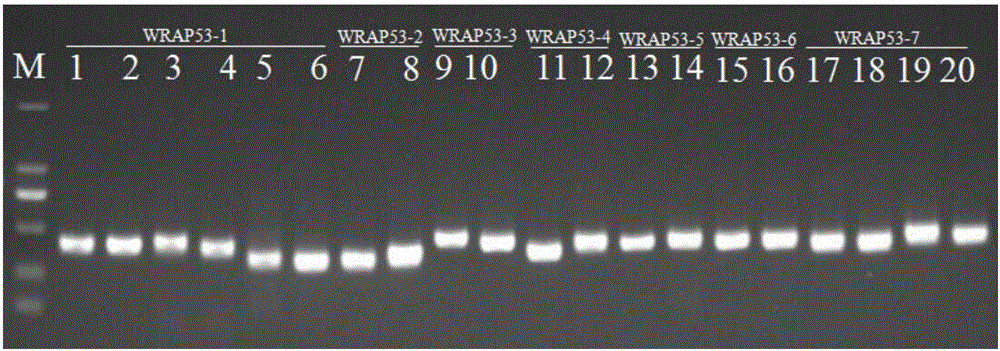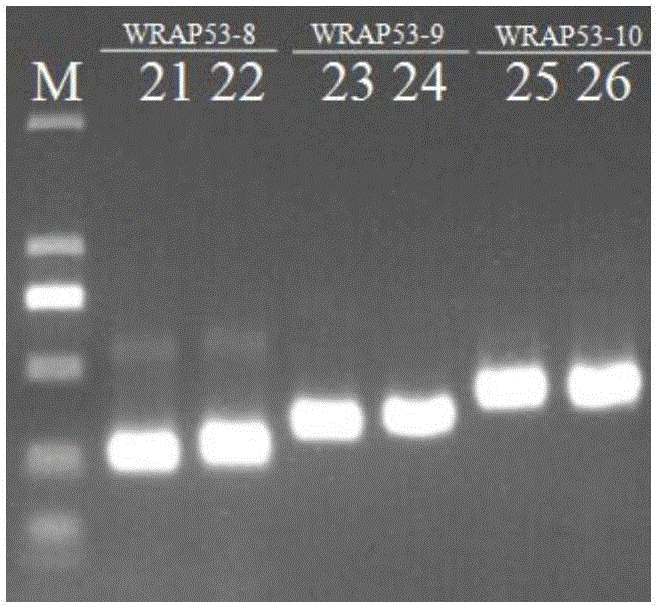Primer for detecting WRAP53 gene mutation and application of primer
A technology for sequencing primers and genes, which is applied in the fields of life sciences and biology, and can solve problems such as fewer cases, less gene detection, and more WRAP53 gene mutation points
- Summary
- Abstract
- Description
- Claims
- Application Information
AI Technical Summary
Problems solved by technology
Method used
Image
Examples
Embodiment 1
[0128] A primer for detecting WRAP53 gene mutation, comprising:
[0129] The primers for amplifying the whole exon sequence of WRAP53 gene, its base sequence is:
[0130] WRAP53-1a F is shown in SEQ ID NO: 1:
[0131] TGTAAAACGACGGCCAGTGGGAACGGGAAACCTTCTAA
[0132] WRAP53-1a R is shown in SEQ ID NO: 2:
[0133] AACAGCTATGACCATGGACAGCAGTCCGGAGCTAAC
[0134] WRAP53-1b F is shown in SEQ ID NO: 3:
[0135] TGTAAAACGACGGCCAGTCTAATCTCCGCTGTGCTTCC
[0136] WRAP53-1b R is shown in SEQ ID NO: 4:
[0137] AACAGCTATGACCATGTCTTCTGCAGGAAGGCTTGT
[0138] WRAP53-1c F is shown in SEQ ID NO: 5:
[0139] TGTAAAACGACGGCCAGTGGGACCCAGTTTCTCTCTCC
[0140] WRAP53-1c R is shown in SEQ ID NO: 6:
[0141] AACAGCTATGACCATGCTGGAGAAGTGGGTCTCAGG
[0142] WRAP53-2F is shown in SEQ ID NO: 7:
[0143] TGTAAAACGACGGCCAGTGTGGAGTCTGGGGAGATGAA
[0144] WRAP53-2R is shown in SEQ ID NO: 8:
[0145] AACAGCTATGACCATGGGGCATCCCTCTCCTAGAAA
[0146] WRAP53-3F is shown in SEQ ID NO: 9:
[0147] TGTAAAACGACG...
Embodiment 2
[0196] Operation process of blood / cell / tissue genomic DNA extraction kit (Tiangen Biology):
[0197] (1) Extraction of genomic DNA in blood: 1) Extract 300 μl of blood and add 900 μl of erythrocyte lysate, mix by inversion, and place at room temperature for 5 minutes, during which time, invert and mix several times. Centrifuge at 12000rpm for 1min, suck off the supernatant, leave the white blood cell pellet, add 200μl buffer GA, shake until thoroughly mixed. 2) Add 20 μl proteinase K solution and mix well. 3) Add 200 μl of buffer GB, mix thoroughly by inversion, place at 70°C for 10 minutes, the solution should become clear, and briefly centrifuge to remove water droplets on the inner wall of the tube cap. 4) Add 200 μl of absolute ethanol, vortex and mix well for 15 seconds. At this time, flocculent precipitates may appear. Briefly centrifuge to remove water droplets on the inner wall of the tube cap. 5) Add the solution and flocculent precipitate obtained in the previous s...
Embodiment 3
[0225] Two cases of clinical samples were taken to extract genomes, prepare reagents, amplify and sequence according to the reagents and methods of Examples 1 and 2. Electrophoresis results such as figure 2 and 3 Shown, show that the primers WRAP53-1a F / R, WRAP53-1b F / R, WRAP53-1cF / R, WRAP53-2F / R, WRAP53-3F / R, WRAP53-4F / R, WRAP53-5F of the present invention / R, WRAP53-6F / R, WRAP53-7aF / R, WRAP53-7bF / R, WRAP53-8F / R, WRAP53-9F / R, WRAP53-10F / R can effectively amplify blood samples with a single band .
[0226] The test results of sample 1 are as follows: Figure 4-13 Shown:
[0227] Figure 4 It shows the wild-type sequencing screenshot of WRAP53 exon 1 of sample 1, indicating that exon 1 of sample 1 is not mutated.
[0228] Figure 5 It shows the wild-type sequencing screenshot of WRAP53 exon 2 of sample 1, indicating that exon 2 of sample 1 is not mutated.
[0229] Figure 6 It shows the wild-type sequencing screenshot of WRAP53 exon 3 of sample 1, indicating that exon...
PUM
 Login to View More
Login to View More Abstract
Description
Claims
Application Information
 Login to View More
Login to View More - R&D
- Intellectual Property
- Life Sciences
- Materials
- Tech Scout
- Unparalleled Data Quality
- Higher Quality Content
- 60% Fewer Hallucinations
Browse by: Latest US Patents, China's latest patents, Technical Efficacy Thesaurus, Application Domain, Technology Topic, Popular Technical Reports.
© 2025 PatSnap. All rights reserved.Legal|Privacy policy|Modern Slavery Act Transparency Statement|Sitemap|About US| Contact US: help@patsnap.com



